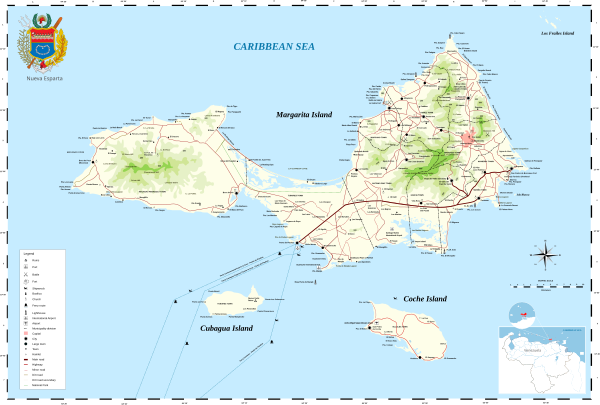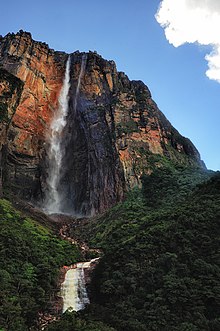Margarita Island is the largest island in the Venezuelan state of Nueva Esparta, situated off the northeastern coast of the country, in the Caribbean Sea. The capital city of Nueva Esparta, La Asunción, is located on the island. Primary industries are tourism, fishing and construction.
Located in the Caribbean Sea between latitudes 10°52'N and 11°11'N and longitudes 63°48'W and 64°23'W, the island, along with the islands of Coche and Cubagua, comprises the state of Nueva Esparta. The island is split into two peninsula joined by an 18 kilometres long ithnus and covers an area of 1,020 km². It is 78 kilometres long and measures roughly 20 kilometres at its widest. The climate is sunny and dry with average temperatures ranging from 24 to 37 °C.
Most of the island's 420,000 residents live in the more developed eastern part of the island, which includes the large cities of Porlamar and Pampatar along with the state capital of La Asunción. The island can be reached by direct flights from Caracas or ferries from Puerto La Cruz, Cumaná, and La Guaira. There are no international flights to the island at present.
The Macanao Peninsula to the west has a central mountain range in the east-west direction. The highest altitude is 760 metres at Pico de Macanao. Several smaller ranges derive from this axis following a north-south orientation with deep valleys between them. The most notable of these valleys is San Francisco in the north-central part of the peninsula. The Paraguachoa peninsula to the East is formed by a mountain range in the north-south direction from Porlamar to Cabo Negro. The highest peaks are San Juan or Cerro Grande at 920 metres and El Copey 890 metres. The peninsulas are connected by the La Restinga isthmus, on which the La Restinga Lagoon is located. There are also two breast shaped hills known as Tetas de Maria Guevara on the isthmus.



